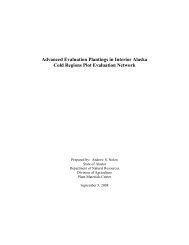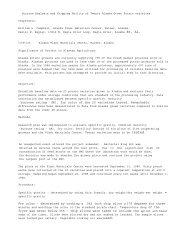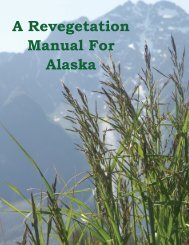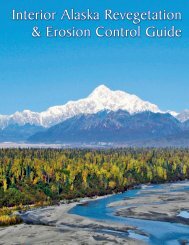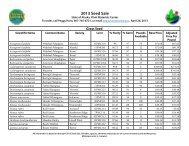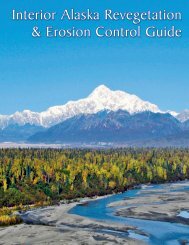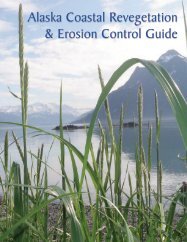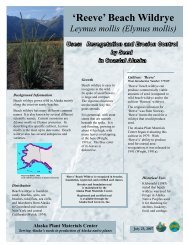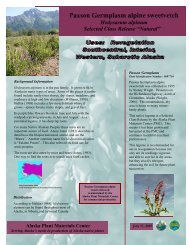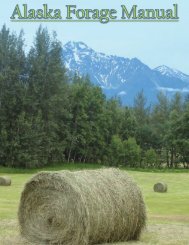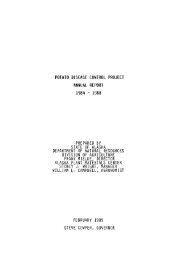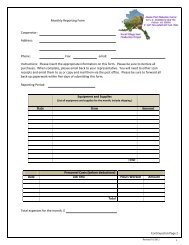Alaska Forage Manual - Alaska Plant Materials Center - State of ...
Alaska Forage Manual - Alaska Plant Materials Center - State of ...
Alaska Forage Manual - Alaska Plant Materials Center - State of ...
You also want an ePaper? Increase the reach of your titles
YUMPU automatically turns print PDFs into web optimized ePapers that Google loves.
ALFALFA<br />
<strong>Forage</strong> Value<br />
Alfalfa produces large amounts <strong>of</strong> protein and is excellent<br />
quality forage for all classes <strong>of</strong> livestock and wildlife. This<br />
legume has the highest feed value <strong>of</strong> all commonly grown hay<br />
crops. Alfalfa is one <strong>of</strong> the most important forage plants in<br />
production agriculture; sometimes called the “Queen <strong>of</strong> the<br />
<strong>Forage</strong>s”. It is high in mineral content and possesses excellent<br />
nutritional value, containing at least 10 different vitamins.<br />
Distribution and Adaptation<br />
Photo: Sten Porse (Wikimedia.org)<br />
Alfalfa<br />
Medicago sativa (L.)<br />
Description<br />
A mature stand <strong>of</strong> Alfalfa<br />
Medicago sativa, Alfalfa is a long lived perennial legume. It<br />
grows erect culms, 76 - 91 centimeters (30 to 36 inches) in<br />
height, branching from a single base. Leaves alternate on the<br />
stem and are pinnately trifoliolate, while individual leaflets are<br />
obovate (ovalish) or lancolate (lance shaped). Alfalfa produces<br />
numerous flowers that are purplish to yellow and borne in loose<br />
racemes or clusters. Alfalfa grows a series <strong>of</strong> lateral roots, with<br />
a distinct tap root that may penetrate 6 to 9 meters (20 to 30<br />
feet) below soil surface. This legume produces a small kidney<br />
shaped seed. Alfalfa produces 190,000 to 220,000 seeds per<br />
pound <strong>of</strong> seed, depending upon variety. Seedling vigor can be<br />
low to moderate, also depending upon the selected variety.<br />
Alfalfa is adapted to a variety <strong>of</strong> climatic and soil conditions,<br />
and can be found growing throughout the United <strong>State</strong>s<br />
and parts <strong>of</strong> Canada. Varieties such as ‘Denali’ have been<br />
hybridized to better withstand extreme <strong>Alaska</strong>n climates.<br />
Generally, Alfalfa prefers deep well drained medium textured<br />
soils, with a pH <strong>of</strong> 6 to 8.5. It is highly drought tolerant and<br />
can withstand saline soils. Alfalfa will not tolerate sites with<br />
frequent overflow or high water tables.<br />
Culture<br />
Alfalfa should be planted no deeper than a ¼ inch on fine<br />
textured soils and ½ inch deep on coarse soils. It should be drill<br />
seeded on a firm seed bed. Cultipacking the soil before and<br />
after planting Alfalfa is normally recommended. Seeding rates<br />
depend greatly upon soil type, moisture, and location. Note<br />
that Alfalfa can have trouble over-wintering and competing<br />
with perennial grasses.<br />
An average seeding rate when broadcasting Alfalfa is 10 lbs/<br />
acre and 5 lbs/acre when drill seeding. All seeding rates are<br />
determined by using Pure Live Seed (PLS) calculations, as<br />
described in Appendix B. Appropriate fertilizer ratios depend<br />
upon soil type, chemistry and location. Research in <strong>Alaska</strong> has<br />
shown that the application <strong>of</strong> fertilizer produces no significant<br />
yield change. If applying fertilizer, collect and analyze soil<br />
samples first. Pastures and hay fields should be irrigated when<br />
necessary and/or applicable.<br />
Uses<br />
Livestock: Alfalfa is typically used for haying, silage, and<br />
pastures land. However, it can also be fed as haylage, wafers,<br />
pellets or dried meal. It is highly palatable to all classes <strong>of</strong><br />
livestock, but caution is advised when feeding Alfalfa due to its<br />
high bloat hazard.<br />
Wildlife: Alfalfa is highly palatable to a variety <strong>of</strong> large wildlife,<br />
such as deer, elk and bison. It is utilized as food and cover by<br />
small mammals, waterfowl and upland game birds. Canada<br />
geese, sandhill cranes, rough grouse and mallard ducks can be<br />
found utilizing Alfalfa.<br />
Management<br />
Alfalfa makes an excellent pasture, hay or silage forage.<br />
Although this crop is usually harvested 2 years after planting,<br />
one should be aware that most varieties will not overwinter<br />
throughout <strong>Alaska</strong>. This can be attributed to several<br />
environmental factors such as acid soils, nutrient deprived<br />
soils, cold stress and damage to the plants root system. There<br />
are several varieties <strong>of</strong> Alfalfa that have been developed or<br />
hybridized to combat these factors.<br />
Alfalfa will tolerate moderate pasture grazing, but stands will<br />
weaken if over grazed or grazed too <strong>of</strong>ten. When applicable,<br />
Alfalfa can be grown with a perennial grass species, such as<br />
71



